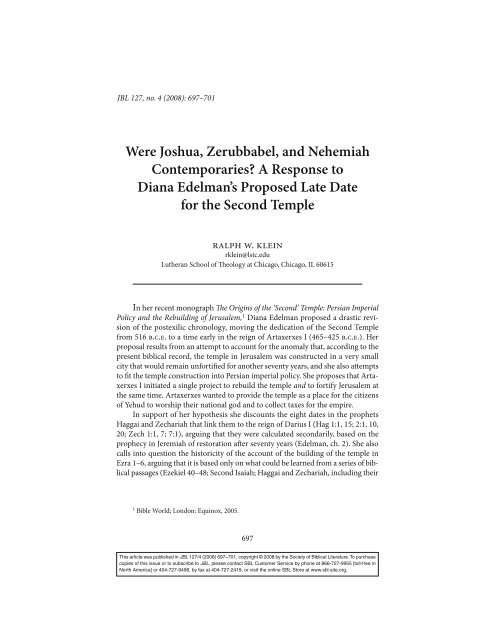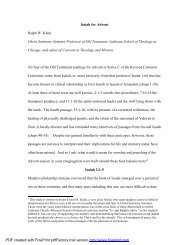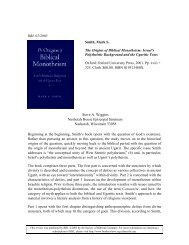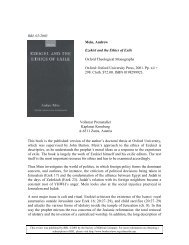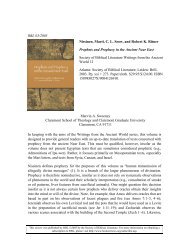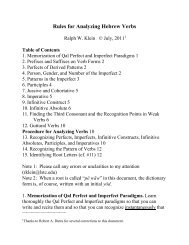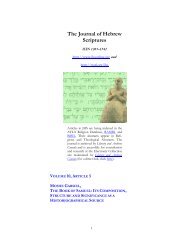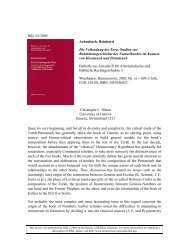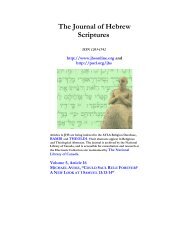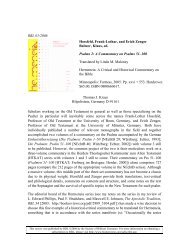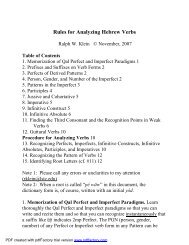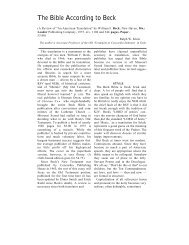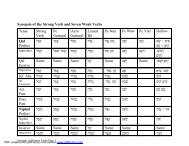Were Joshua, Zerubbabel, and Nehemiah Contemporaries? A ...
Were Joshua, Zerubbabel, and Nehemiah Contemporaries? A ...
Were Joshua, Zerubbabel, and Nehemiah Contemporaries? A ...
You also want an ePaper? Increase the reach of your titles
YUMPU automatically turns print PDFs into web optimized ePapers that Google loves.
JBL 127, no. 4 (2008): 697–701<br />
<strong>Were</strong> <strong>Joshua</strong>, <strong>Zerubbabel</strong>, <strong>and</strong> <strong>Nehemiah</strong><br />
<strong>Contemporaries</strong>? A Response to<br />
Diana Edelman’s Proposed Late Date<br />
for the Second Temple<br />
ralph w. klein<br />
rklein@lstc.edu<br />
Lutheran School of Theology at Chicago, Chicago, IL 60615<br />
In her recent monograph The Origins of the ‘Second’ Temple: Persian Imperial<br />
Policy <strong>and</strong> the Rebuilding of Jerusalem, 1 Diana Edelman proposed a drastic revision<br />
of the postexilic chronology, moving the dedication of the Second Temple<br />
from 516 b.c.e. to a time early in the reign of Artaxerxes I (465–425 b.c.e.). Her<br />
proposal results from an attempt to account for the anomaly that, according to the<br />
present biblical record, the temple in Jerusalem was constructed in a very small<br />
city that would remain unfortified for another seventy years, <strong>and</strong> she also attempts<br />
to fit the temple construction into Persian imperial policy. She proposes that Artaxerxes<br />
I initiated a single project to rebuild the temple <strong>and</strong> to fortify Jerusalem at<br />
the same time. Artaxerxes wanted to provide the temple as a place for the citizens<br />
of Yehud to worship their national god <strong>and</strong> to collect taxes for the empire.<br />
In support of her hypothesis she discounts the eight dates in the prophets<br />
Haggai <strong>and</strong> Zechariah that link them to the reign of Darius I (Hag 1:1, 15; 2:1, 10,<br />
20; Zech 1:1, 7; 7:1), arguing that they were calculated secondarily, based on the<br />
prophecy in Jeremiah of restoration after seventy years (Edelman, ch. 2). She also<br />
calls into question the historicity of the account of the building of the temple in<br />
Ezra 1–6, arguing that it is based only on what could be learned from a series of biblical<br />
passages (Ezekiel 40–48; Second Isaiah; Haggai <strong>and</strong> Zechariah, including their<br />
1 Bible World; London: Equinox, 2005.<br />
697<br />
This article was published in JBL 127/4 (2008) 697–701, copyright © 2008 by the Society of Biblical Literature. To purchase<br />
copies of this issue or to subscribe to JBL, please contact SBL Customer Service by phone at 866-727-9955 [toll-free in<br />
North America] or 404-727-9498, by fax at 404-727-2419, or visit the online SBL Store at www.sbl-site.org.
698 Journal of Biblical Literature 127, no. 4 (2008)<br />
dates; <strong>and</strong> 1 Chronicles 22–2 Chronicles 7; Edelman, ch. 3). 2 Two additional chapters<br />
investigate the size of Yehud in the fifth century (ch. 4) <strong>and</strong> the archaeological<br />
data that support her hypothesis (ch. 5). Chapter 6 contains her description of the<br />
pragmatic issues that led Artaxerxes to fortify Jerusalem <strong>and</strong> rebuild the temple at<br />
the beginning of his reign.<br />
Responding to Edelman’s impressive arguments throughout the book would<br />
require a monograph of nearly the same size; this note will contest only one crucial<br />
item, her attempt through genealogical research to make <strong>Joshua</strong> 3 <strong>and</strong> <strong>Zerubbabel</strong>,<br />
on the one h<strong>and</strong>, <strong>and</strong> <strong>Nehemiah</strong>, on the other, near contemporaries. She makes her<br />
case for this in ch. 1 (pp. 13–79), although she locates also many other persons<br />
genealogically in this chapter. 4 If her attempt to make <strong>Joshua</strong>, <strong>Zerubbabel</strong>, <strong>and</strong><br />
<strong>Nehemiah</strong> near contemporaries can be called into question, however, the more traditional<br />
date for the construction of the Second Temple, unanimously supported by<br />
Haggai, Zechariah 1–8, <strong>and</strong> Ezra 1–6, is quite likely to st<strong>and</strong>.<br />
Edelman (pp. 38–40) defends the idea that <strong>Nehemiah</strong> himself served during<br />
the reign of Artaxerxes, as in the biblical text, because of a reference to Sanballat<br />
(the arch-rival of <strong>Nehemiah</strong> in the book of <strong>Nehemiah</strong>) <strong>and</strong> his two sons in Elephantine<br />
papyrus 30, dated to 408 b.c.e., <strong>and</strong> the resultant calculations about Sanballat’s<br />
relative date of birth <strong>and</strong> his age during the time of <strong>Nehemiah</strong>.<br />
I. The Chronological Date of <strong>Joshua</strong><br />
The Bible makes the high priest <strong>Joshua</strong>, under whom the temple was built, a<br />
contemporary of Haggai <strong>and</strong> Zechariah, who advocated strongly for constructing<br />
the temple in the early years of Darius I. <strong>Joshua</strong> appears in the following genealogy<br />
of priests. 5<br />
2 The only exception to such inner-biblical information is the governor Sheshbazzar, whose<br />
name she thinks is fictional. Edelman further denies the authenticity of the Persian documents in<br />
Ezra. 3 I have chosen to use the spelling of names that are used in st<strong>and</strong>ard English Bibles, except<br />
where I quote Edelman’s translation of 1 Chr 3:17–18. Edelman uses throughout spellings more<br />
similar to their Hebrew pronunciation, but does not use the transliteration style used in The SBL<br />
H<strong>and</strong>book of Style.<br />
4 Edelman suggests that Meshullam the son of Berechiah (Neh 3:30) is the younger brother<br />
of the prophet Zechariah. But if this Meshullam is the same as the one mentioned in Neh 3:4,<br />
Meshullam’s gr<strong>and</strong>father was Meshezabel <strong>and</strong> not Iddo. This also negates her assertion that the<br />
daughter of Meshullam in Neh 6:18 is the niece of the prophet Zechariah. She makes Hananiah<br />
in Neh 7:2 the son of <strong>Zerubbabel</strong> though no patronymic is given for him. If her genealogical<br />
reconstructions of <strong>Joshua</strong> <strong>and</strong> <strong>Zerubbabel</strong> are wrong, Hananiah also cannot chronologically be<br />
the son of <strong>Zerubbabel</strong>.<br />
5 For detailed discussion of these priests, see James C. V<strong>and</strong>erKam, From <strong>Joshua</strong> to Caiaphas:<br />
High Priests after the Exile (Minneapolis: Fortress, 2004), 43–111.<br />
This article was published in JBL 127/4 (2008) 697–701, copyright © 2008 by the Society of Biblical Literature. To purchase<br />
copies of this issue or to subscribe to JBL, please contact SBL Customer Service by phone at 866-727-9955 [toll-free in<br />
North America] or 404-727-9498, by fax at 404-727-2419, or visit the online SBL Store at www.sbl-site.org.
Klein: A Response to Diana Edelman 699<br />
Seraiah The last priest of the first temple, executed by Nebuchadnezzar<br />
(2 Kgs 25:18–21)<br />
Jehozadak The successor of Seraiah, who was deported by Nebuchadnezzar<br />
(1 Chr 5:40–41 [Eng. 6:14–15])<br />
<strong>Joshua</strong> (Jeshua) Identified as the son of Jehozadak (Jozadak) by Ezra 3:2 <strong>and</strong><br />
Hag 1:1<br />
Joiakim Neh 12:10, 12, 26 6<br />
Eliashib Neh 3:1, 20–21; 12:10, 22; 13:28<br />
Joiada Neh 12:10–11, 22; 13:18<br />
Johanan Neh 12:22–23; Jonathan Neh 12:11 7<br />
There are only a few fixed dates that are helpful. Seraiah died in 586; <strong>Joshua</strong> was<br />
high priest in 520, according to the st<strong>and</strong>ard chronology; Eliashib was high priest<br />
in 444; <strong>and</strong> Johanan was high priest in 408. Hypothetical dates of birth <strong>and</strong> death<br />
make this genealogy plausible. If Seraiah would have been forty at his death in 586<br />
(hence born in ca. 626), his son Jehozadak could have been born in ca. 606 b.c.e.<br />
<strong>Joshua</strong> would then be born ca. 586 <strong>and</strong> would have been seventy when the temple<br />
was dedicated in 516. Clearly, <strong>Joshua</strong> would not have been alive in 465, when,<br />
according to Edelman, Artaxerxes I began his reign <strong>and</strong> initiated the construction<br />
of the Second Temple. Edelman addresses this chronological issue by saying that<br />
Jehozadak may have been the gr<strong>and</strong>son or great-gr<strong>and</strong>son of Seraiah, thus arbitrarily<br />
adding twenty to forty years to the birth date of <strong>Joshua</strong>, making him born<br />
in 566 or even 546. This would make him 101 or eighty-one at the accession of<br />
Artaxerxes. The first age is impossible <strong>and</strong> the second highly unlikely, perhaps<br />
requiring that Jehozadak be the great-great-gr<strong>and</strong>son of Seraiah. Edelman (p. 19)<br />
also offers the possibility that Jehozadak <strong>and</strong> Seraiah were not related to each other<br />
at all, which means that she can assign whatever dates she wants to for the subsequent<br />
priests. The calculations would change somewhat if the dates of the first son<br />
were lengthened to an average of twenty-five years, but clearly she can bring <strong>Joshua</strong><br />
into the proper chronological horizon only by arbitrarily lengthening his genealogy<br />
by two or, more probably, three generations.<br />
II. <strong>Zerubbabel</strong><br />
A genealogy of <strong>Zerubbabel</strong> is provided in 1 Chr 3:16–19:<br />
6 Frank Moore Cross, Jr., inserted two additional names at this point, Eliashib <strong>and</strong> Johanan<br />
(“A Reconstruction of the Judean Restoration,” JBL 94 [1975]: 4–18). For a critical discussion of<br />
this proposal, see V<strong>and</strong>erKam, High Priests, 85–97. Edelman also rejects the proposal of Cross.<br />
7 V<strong>and</strong>erkam suggests that Jonathan is a copyist’s mistake for Johanan (High Priests, 54–<br />
55).<br />
This article was published in JBL 127/4 (2008) 697–701, copyright © 2008 by the Society of Biblical Literature. To purchase<br />
copies of this issue or to subscribe to JBL, please contact SBL Customer Service by phone at 866-727-9955 [toll-free in<br />
North America] or 404-727-9498, by fax at 404-727-2419, or visit the online SBL Store at www.sbl-site.org.
700 Journal of Biblical Literature 127, no. 4 (2008)<br />
Jeconiah (Jehoiachin)——— Shealtiel<br />
Malchiram<br />
Pedaiah———<strong>Zerubbabel</strong><br />
Shenazzar<br />
Jekamiah<br />
Hoshama<br />
Nedabiah<br />
According to 2 Kgs 24:8, Jehoiachin was born in 615, since he came to the<br />
throne when he was eighteen in 597, <strong>and</strong> it is known that he was still alive, at fiftyfour,<br />
in 561 (2 Kgs 25:27). Assuming that Jehoiachin had his first child at eighteen<br />
or twenty, Pedaiah, his third son, would have been born in the mid to late 590s, 8<br />
which seems plausible, since Babylonian records indicate that Jehoiachin had five<br />
sons who were given provisions in captivity by 592. If <strong>Zerubbabel</strong> was born in ca.<br />
573, he would have been fifty-three when he is mentioned by Haggai, Ezra, <strong>and</strong><br />
<strong>Nehemiah</strong> during the reign of Darius I, ca. 520. By the time of Artaxerxes he would<br />
have been 108 <strong>and</strong> presumably long since dead.<br />
The study of the genealogy of <strong>Zerubbabel</strong> has long been plagued by notices in<br />
Ezra (3:2), <strong>Nehemiah</strong> (12:1), <strong>and</strong> Haggai (1:1) that <strong>Zerubbabel</strong>’s father was Shealtiel,<br />
the oldest son of Jeconiah, <strong>and</strong> not Pedaiah. Numerous attempts have been made<br />
to explain this discrepancy, often by the hypothesis that Shealtiel died before siring<br />
a son, <strong>and</strong> that his younger brother Pedaiah married his widow <strong>and</strong> engendered a<br />
son in Shealtiel’s name. After discussing this hypothesis <strong>and</strong> several other solutions<br />
<strong>and</strong> finding them unsatisfactory, Edelman calls attention to an unusual wording in<br />
the list of the sons of Jeconiah in 1 Chr 3:17–18: 9 “<strong>and</strong> the sons of Jeconiah, the<br />
captive: Shealtiel his son, <strong>and</strong> Malchiram, Pedaiah, Shenazzar, Jekamiah, Hoshama,<br />
<strong>and</strong> Nedabiah.” This could be taken to mean that Shealtiel was the only descendant<br />
of Jeconiah mentioned, <strong>and</strong> his name is then followed by the list of six additional<br />
names. This list could be taken to mean that these six additional males were all sons<br />
of Shealtiel instead of Jeconiah, but the genealogy continues with the lineage of<br />
Pedaiah, who would be Shealtiel’s second oldest son. Edelman (p. 21) thinks that the<br />
link should continue from the oldest son. 10 She therefore emends the genealogy to<br />
read as follows (with additions indicated in brackets): “the descendants of Yekoniah<br />
the captive: Shealtiel, his son, Malkiram [his son], <strong>and</strong> [the sons of Malkiram]:<br />
Pedaiah, Shenazzer, Yekamiah, Hoshama, Nedeviah [five]” (p. 21).<br />
8 Edelman (Origins, 21) sets Shealtiel’s birth at 597. There is no indication of how many<br />
wives were involved in bearing Jehoiachin’s children.<br />
9 For discussion of other details of this genealogy, see Gary N. Knoppers, 1 Chronicles 1–9:<br />
A New Translation with Introduction <strong>and</strong> Commentary (AB 12; New York: Doubleday, 2004), 320–<br />
21, 327–28; <strong>and</strong> Ralph W. Klein, 1 Chronicles: A Commentary (Hermeneia; Minneapolis: Fortress,<br />
2006), 109–10, 119–20. Both commentaries retain <strong>Zerubbabel</strong> as the gr<strong>and</strong>son of Jeconiah.<br />
10 It should be noted, however, that in the two generations after <strong>Zerubbabel</strong> descendants<br />
do not come from the oldest son.<br />
This article was published in JBL 127/4 (2008) 697–701, copyright © 2008 by the Society of Biblical Literature. To purchase<br />
copies of this issue or to subscribe to JBL, please contact SBL Customer Service by phone at 866-727-9955 [toll-free in<br />
North America] or 404-727-9498, by fax at 404-727-2419, or visit the online SBL Store at www.sbl-site.org.
Klein: A Response to Diana Edelman 701<br />
The resulting (simplified) genealogy would look like this:<br />
Jeconiah—Shealtiel—Malchiram—Pedaiah—<strong>Zerubbabel</strong><br />
This conjectural emendation, therefore, has added two generations to <strong>Zerubbabel</strong>’s<br />
genealogy (he is not the gr<strong>and</strong>son, but the great-great-gr<strong>and</strong>son of<br />
Jehoiachin). In Edelman’s judgment, this brings <strong>Zerubbabel</strong> to the same generation<br />
as <strong>Nehemiah</strong>, or to the immediately preceding generation. She conjectures a<br />
birth date for <strong>Zerubbabel</strong> of approximately 500.<br />
Assigning more realistic absolute dates to these figures, however, points out a<br />
major discrepancy. Since Jeconiah was born in 615, the following generations in<br />
the genealogy could be dated as follows: Shealtiel 597; Malchiram 577; Pedaiah 557;<br />
<strong>Zerubbabel</strong> 537. That is, after adding two generations by emendation, Edelman<br />
really has to add another generation to get a birth date for <strong>Zerubbabel</strong> that would<br />
locate him as an active leader in the early years of Artaxerxes, with a birth date of<br />
ca. 500.<br />
Because of the severe chronological difficulties with both <strong>Joshua</strong> <strong>and</strong> <strong>Zerubbabel</strong>,<br />
even after Edelman’s textual changes, I believe her proposal for a late date<br />
for the Second Temple is not plausible. Since all the other biblical data are against<br />
it in any case, she absolutely must resolve the chronological problems with <strong>Joshua</strong><br />
<strong>and</strong> <strong>Zerubbabel</strong> if her radical hypothesis is to have a chance of succeeding.<br />
This article was published in JBL 127/4 (2008) 697–701, copyright © 2008 by the Society of Biblical Literature. To purchase<br />
copies of this issue or to subscribe to JBL, please contact SBL Customer Service by phone at 866-727-9955 [toll-free in<br />
North America] or 404-727-9498, by fax at 404-727-2419, or visit the online SBL Store at www.sbl-site.org.


